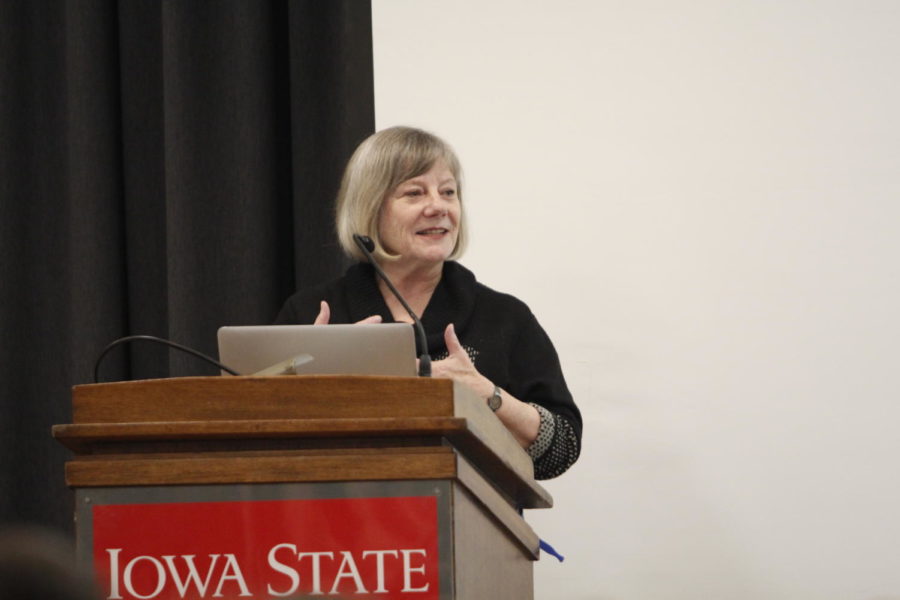Lecturer speaks on what is really important to a conversation
Tracey Derwing speaks about the importance of understanding second language speakers Tuesday at the Memorial Union. “Second language accent can definitely have an extraordinary affect on a person’s life,” Derwing said.
April 16, 2019
Tracey Derwing, a professor at the University of Alberta, spoke about what really matters when understanding second language speakers Tuesday.
Derwing’s title for her presentation was “Accent-Schmaccent,” because accent doesn’t matter when understanding a second language speaker.
“Accent does matter, it can be a matter of life or death especially for asylum seekers,” Derwing said.
Derwing explained how countries like the United States and Canada use Language Analysis for Determination of Origin (LADO), which oftentimes uses unreliable methods of determining asylum seekers’ validity that are often wrong. In a lot of spaces accent stereotyping goes on, which negatively impacts all involved.
One example of this was a call center test where the end result concluded that callers reacted more positively to native speakers rather than accented speakers, especially when it came to bad news.
Derwing explained the four dimensions of speech that affect a person’s ability to understand another person.
The first dimension was accent, which is a salient difference between a speaker and listener speech. Some examples of this are “out” versus “loud” and “ice” versus “eyes.”
The second dimension was comprehensibility, which is the ease of understanding on the listener’s part. This is often ranked on a one to nine scale, with one being easy to understand and nine being difficult. Derwing played a sound byte of a woman speaking with an accent, and the majority of people rated it under five.
The third dimension was fluency, which is the “flow” of speech, such as speech rate. This is also ranked the same as comprehensibility. Derwing played a sound byte of a man with a Vietnamese accent talking about fatigue and rated him very disfluent.
The fourth dimension was intelligibility, which is how much of the speaker’s intended message was understood. Derwing did a math problem of “2+2-1” spoken out loud to give an example of intelligibility.
Derwing showed a commercial for the Rockwell Automation “Retro Encabulator,” where the speaker used many large and made-up words that the common populace would not know or understand. Derwing explained that it was a hoax created in 1946, and was deliberately unintelligible.
She also showed a Britain parliament video where a Scottish man with a heavy accent proposed something concerning accessibility to a government building, but another man in the Parliament had to ask multiple times for the Scottish man to repeat the proposal due to the heavy Scottish accent.
“For me he was intelligible, but his comprehensibility was hard,” Derwing said.
Derwing also showed a Sofia Vergara movie clip showing that second language speakers can be both intelligible and comprehensible and a clip of a Vietnamese worker where a word was heard as “stockett” but it was actually the word “target” to show that the man’s intelligibility was lacking.
“As long as you are intelligible and comprehensible, accent doesn’t really matter,” Derwing said.
Derwing then went to explain the three different models of pronunciation teaching.
The first model is the Medical Model, which views accent as a disorder, disease or something that needs therapy to fix. People within this model are speech language pathologists, and a study showed that many of them are not trained to deal with second language accents.
Derwing showed a blog post of a person with a degree in speech and hearing services, in which the individual explained that they have no idea what they are doing but still take clients.
“She is charging people for a service, but paradoxically has no idea what she’s doing,” Derwing said.
The second model is the Business Model, which focuses on commodifying second language speakers.
For an example, Derwing used Andy Krieger, a “speech coach” hired by a state to help language teachers lose their accents. Krieger claims that there are no syllables in American English and says that learners need to “wack” the front of the word and rush through it.
“I think this technique is wacky,” Derwing said.
The third model is the Education Model, which focuses on pronunciation teaching.
Derwing said that this model was the best model to help second language speakers, even though a study showed that teachers used little to no pronunciation instruction in their classes.
Derwing recommended the usage of pronunciationforteachers.com, which was created by John Levis, a professor in English at Iowa State.
Derwing ended her presentation by saying that both the speaker and the listener have to put effort into the conversation for it to work.
“Every conversation is the responsibility of everyone involved,” Derwing said.







